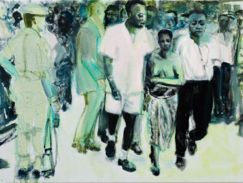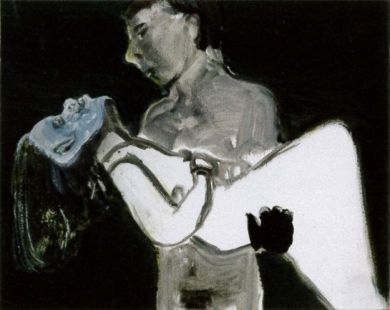Tate Modern hosts SA-born Dumas
5 February 2015
The Tate Modern in London is hosting a retrospective exhibition for South African-born
painter Marlene Dumas.
The exhibition, titled
The Image as Burden and made up of more than 100
paintings and drawings, opened on 5 February and will run until 10 May. It was curated
by Helen Sainsbury.
In 2005, Dumas' painting
The Victor sold for £3.1-million, making her the
most expensive living female artist in the world.
Dumas was born in Kuilsriver in 1953. After studying at UCT's Michaelis Art School, she
left South Africa in 1976 on a scholarship to study at the Atelier '63 in Haarlem, Holland,
and nearly four decades later, she still lives in the country's capital, Amsterdam.
In 2008, Dumas returned to South Africa where the Standard Bank Gallery in
Johannesburg hosted her first solo exhibition in the country.
Dumas creates paintings from photographs. Her subject matter ranges from "monstrous
newborns and terrorists to murdered children and bodies in morgues", the Telegraph's
Alistair Smart writes in his review of the show.
"So what can they expect? Well, perhaps it’s easier to say what not to expect: a barrel
of laughs. In the joy and jubilation stakes, this is about as far removed as it gets from
Matisse’s cut-outs, on show at Tate last year."
Dumas
work grapples with themes around life and death, politics, sexuality, race,
gender, colonialism, and the role of the media and celebrity in modern life.
The exhibition is the most significant exhibition of her work ever to be held in Europe,
charting her career from early works, through seminal paintings to new works on paper,
the Tate says on its website.
The title of the exhibition is taken from
The Image as Burden 1993, a
small painting depicting one figure carrying another.
She has painted portaits of Princess Diana, Amy Winehouse, Phil Spector and Bin Laden.
There are scenes from Amsterdam's sex clubs and rural South Africa.
In one of her texts on the wall of the gallery, Dumas writes: "I could say South Africa is
my content." But, as Ben Luke writes in the
Evening Standard, she doesn’t mean this literally – "rather, I
think, that this conflicted, troubling background
led to conflicted, troubling art."
SAinfo reporter
 The Widow, a portrait by Marlene Dumas of a bare-breasted Pauline Lumumba, wife of the first democratically elected prime minister of the Democratic Republic of Congo (Image: Marlene Dumas)
The Widow, a portrait by Marlene Dumas of a bare-breasted Pauline Lumumba, wife of the first democratically elected prime minister of the Democratic Republic of Congo (Image: Marlene Dumas)




